Critical State Calculation of Saddle-Shaped Unstable Region of the Axial-Flow Pump Based on Bifurcation SST k–ω Model
Abstract
1. Introduction
2. Mathematical Description
2.1. Governing Equations
2.2. Turbulence Models
2.2.1. The Original SST k–ω Model
2.2.2. The Modified Bifurcation SST k–ω Model (Named as BSkO Model)
2.3. Calculation Method Verification
2.3.1. Computational Case
2.3.2. Computational Setup
2.3.3. Results and Discussion
3. Numerical Simulation
3.1. Case Description and Computational Setup
3.2. Mesh Generation and Validation
4. Results and Discussion
4.1. The Internal Flow Pattern of the Impeller
4.2. The internal Pressure Fluctuation of the Impeller
4.2.1. The Pressure Fluctuation at the Fixed Monitoring Point
4.2.2. The Pressure Fluctuation at the Rotation Monitoring Point
5. Conclusions
- The head starts to decline when the flow rate drops to 0.55Qd, whereas the internal flow field characteristics in the impeller exhibit changes at 0.6Qd. Therefore, there is a certain lag that uses the inflection point of the head-flow curve as the critical state criterion for the axial-flow pump to enter the saddle-shaped unstable region.
- The leading-edge separation occurs at the LE of the blade SS at 0.7Qd, resembling a two-dimensional separation bubble. However, there is no three-dimensional LESV formed. As the flow rate decreases, the three-dimensional LESV is formed at 0.6Qd, gradually increasing in size as the flow rate drops further. At 0.4Qd, the leading-edge separation weakens and detaches from the leading-edge surface of the blade.
- As the flow rate decreases, a significant increase in the vorticity stretching term occurs at the leading edge of the blade suction surface at 0.6Qd. This indicates a sharp change in velocity gradient, which causes distortion of the streamline and promotes the formation of the LESV. The vorticity stretching term moves toward the leading edge as the flow rate decreases. Finally, the LESV breaks away from the blade surface.
- The frequency domain distribution of fixed monitoring points did not exhibit significant amplitude, main frequency, and periodicity changes at the critical condition. Therefore, the fixed monitoring point is unsuitable for identifying the critical state. However, the SSU1 monitoring points located on the leading edge of the blade suction near the shroud rotate with the impeller, and its frequency domain diagram changes significantly with the flow rate. Therefore, it is suitable to be used as the criterion to monitor the critical state. When the amplitude of the pressure fluctuation coefficient is increased by ten times, the main frequency position is shifted, and accompanied by abundant low-frequency fluctuations, and the axial-flow pump enters the critical state.
- The pressure fluctuation coefficient amplitude of the monitoring points rotating with the impeller is significantly lower than that of the fixed monitoring points. At the leading edge of the blade suction surface, the amplitude of the SSU1 is much larger than SSM1 and SSB1. As the flow rate decreases, the influence range of the leading-edge separation vortex increases, resulting in a slight increase in the pressure fluctuation amplitude of the SSM1, which is larger than that of SSB1. At the trailing edge of the blade suction surface, there is a slight difference in the radial direction. Furthermore, the amplitude of the SSU1 is much larger than the PSU1, APASU1, and BPASU1.
Author Contributions
Funding
Institutional Review Board Statement
Informed Consent Statement
Data Availability Statement
Acknowledgments
Conflicts of Interest
References
- Guo, Z.; Xia, W.; Qian, Z. Study on noise of an axial flow waterjet pump with wavy leading edge. Ocean. Eng. 2022, 261, 112117. [Google Scholar] [CrossRef]
- Huang, R.; Wang, Y.; Du, T.; Luo, X.; Zhang, W.; Dai, Y. Mechanism analyses of the unsteady vortical cavitation behaviors for a waterjet pump in a non-uniform inflow. Ocean. Eng. 2021, 233, 108798. [Google Scholar] [CrossRef]
- Gong, J.; Wu, Z.; Ding, J.; Jiang, J.; Zhang, Z. Numerical analysis of propulsion performance of a waterjet-propelled vehicle in steady drift. Ocean. Eng. 2022, 266, 113136. [Google Scholar] [CrossRef]
- Lavis, D.R.; Forstell, B.G.; Purnell, J.G. Compact waterjets for high-speed ships. Ships Offshore Struct. 2007, 2, 115–125. [Google Scholar] [CrossRef]
- Zhang, L.; Zhang, J.N.; Shang, Y.C. A potential flow theory and boundary layer theory based hybrid method for waterjet propulsion. J. Mar. Sci. Eng. 2019, 7, 113. [Google Scholar] [CrossRef]
- Wang, X.; Zhang, Z.; Zhang, M. Three-dimensional inverse design and hydrodynamic performance analysis of contra-rotating axial flow pump. Adv. Eng. Res. 2017, 114, 601–608. [Google Scholar] [CrossRef][Green Version]
- Wang, X.E.; Zhang, Z.S.; Zhang, M. Design and Performance Analysis of Contra-rotating Pumpjet Propulsor under Condition of Torque Unbalance. In Proceedings of the MATEC Web of Conferences, Darmstadt, Germany, 18–20 April 2018. [Google Scholar] [CrossRef]
- Cao, L.; Watanabe, S.; Imanishi, T.; Yoshimura, H.; Furukawa, A. Experimental analysis of flow structure in contra-rotating axial flow pump designed with different rotational speed concept. J. Therm. Sci. 2013, 22, 345–351. [Google Scholar] [CrossRef]
- Zheng, F.; Zhang, X.; Chen, T.; Huang, B.; Xu, J.; Wang, G. Strong transient characteristics in axial flow waterjet pump during rapid starting period with special emphasis on saddle zone. Ocean. Eng. 2023, 269, 113506. [Google Scholar] [CrossRef]
- Li, C.; Weijun, Q. Rotating stall region of water-jet pump. Trans. Famena 2014, 38, 31–40. [Google Scholar]
- Shen, J.; Pei, J.; Wang, W.; Yuan, S. Instability characteristics regarding the saddle-shaped region in a reversible mixed-flow pump applied to the low-head pumped storage. J. Energy Storage 2023, 63, 107035. [Google Scholar] [CrossRef]
- Xia, C.; Cheng, L.; Luo, C.; Jiao, W.; Zhang, D. Hydraulic characteristics and measurement of rotating stall suppression in a waterjet propulsion system. Trans. Famena 2018, 42, 85–100. [Google Scholar] [CrossRef]
- Hu, F.; Wu, P.; Wu, D.; Wang, L. Numerical study on the stall behavior of a water jet mixed-flow pump. J. Mar. Sci. Technol. 2014, 19, 438–449. [Google Scholar] [CrossRef]
- Zhang, Y.; Wu, Y. A review of rotating stall in reversible pump turbine. Proc. Inst. Mech. Eng. Part C J. Mech. Eng. Sci. 2017, 231, 1181–1204. [Google Scholar] [CrossRef]
- Shen, X.; Zhao, X.; Xu, B.; Zhang, D.; Yang, G.; Shi, W.; Esch, B.P.M. Unsteady characteristics of tip leakage vortex structure and dynamics in an axial flow pump. Ocean. Eng. 2022, 266, 112850. [Google Scholar] [CrossRef]
- Mu, T.; Zhang, R.; Xu, H.; Fei, Z.; Feng, J.; Jin, Y.; Zheng, Y. Improvement of energy performance of the axial-flow pump by groove flow control technology based on the entropy theory. Energy 2023, 274, 127380. [Google Scholar] [CrossRef]
- Liu, C. Researches and developments of axial-flow pump system. Trans. Chin. Soc. Agric. Mach. 2015, 46, 49–59. [Google Scholar] [CrossRef]
- Xu, L.; Lu, L.; Chen, W.; Wang, G. Flow pattern analysis on inlet and outlet conduit of shaft tubular pump system of Pizhou pumping station in South-to-North Water Diversion Project. Trans. Chin. Soc. Agric. Eng. 2012, 28, 50–56. [Google Scholar] [CrossRef]
- Zhang, D.S.; Shi, W.D.; Chen, B.; Guan, X.F. Unsteady flow analysis and experimental investigation of axial-flow pump. J. Hydrodyn. 2010, 22, 35–43. [Google Scholar] [CrossRef]
- Li, W.; Li, S.; Ji, L.; Li, E.; Shi, W.; Agarwal, R.; Awais, M. Effect of inlet elbow on rotation stall in waterjet propulsion pump. Fundam. Res. 2022. [Google Scholar] [CrossRef]
- Li, Z.; Yang, M.G.; Zhang, N.; Gao, B. Experimental study on vibration characteristics of axial-flow pump under different operating conditions. J. Eng. Thermophys. 2013, 34, 866–869. [Google Scholar]
- Pérez Flores, P.; Kosyna, G.; Wulff, D. Suppression of performance curve instability of an axial-flow pump by using a double-inlet-nozzle. Int. J. Rotating Mach. 2008, 2008, 536850. [Google Scholar] [CrossRef]
- Goltz, I.; Kosyna, G.; Delgado, A. Eliminating the head instability of an axial-flow pump using axial grooves. Proc. Inst. Mech. Eng. Part A J. Power Energy 2013, 227, 206–215. [Google Scholar] [CrossRef]
- Goltz, I.; Kosyna, G.; Stark, U.; Saathoff, H.; Bross, S. Stall inception phenomena in a single-stage axial-flow pump. Proc. Inst. Mech. Eng. Part A J. Power Energy 2003, 217, 471–479. [Google Scholar] [CrossRef]
- Toyokura, T. Studies on the Characteristics of Axial-Flow Pumps: Part 1, General Tendencies of the Characteristics of Pumps. Bull. JSME 1961, 4, 287–293. [Google Scholar] [CrossRef]
- Zhang, R. Research on the Stall and Cavitation Flow Characteristics and the Performance Improvement of Axial-Flow Pump. Ph.D. Thesis, Shanghai University, Shanghai, China, 2014. [Google Scholar]
- Day, I.J. Stall, surge, and 75 years of research. J. Turbomach. 2016, 138, 011001. [Google Scholar] [CrossRef]
- Yamada, K.; Kikuta, H.; Iwakiri, K.; Furukawa, M.; Gunjishima, S. An Explanation for Flow Features of Spike-Type Stall Inception in an Axial Compressor Rotor. J. Turbomach. 2012, 135, 021023. [Google Scholar] [CrossRef]
- Paduano, J.D.; Greitzer, E.M.; Epstein, A.H. Compression system stability and active control. Annu. Rev. Fluid Mech. 2001, 33, 491–517. [Google Scholar] [CrossRef]
- Tan, C.S.; Day, I.; Morris, S.; Wadia, A. Spike-type compressor stall inception, detection, and control. Annu. Rev. Fluid Mech. 2010, 422, 275–300. [Google Scholar] [CrossRef]
- Tahara, N.; Kurosaki, M.; Ohta, Y.; Outa, E.; Nakajima, T.; Nakakita, T. Early stall warning technique for axial-flow compressors. J. Turbomach. 2007, 129, 375–384. [Google Scholar] [CrossRef]
- Wang, F.J.; Zhang, L.; Zhang, Z.M. Analysis on pressure fluctuation of unsteady flow in axial-flow pump. J. Hydraul. Eng. 2007, 38, 1003–1009. [Google Scholar]
- Zheng, Y.; Liu, J.; Zhou, D.Q.; Mao, Y.T.; Liu, M.Q. Pressure pulsation of model test in large-size axial-flow pump. J. Drain. Irrig. Mach. Eng. 2010, 28, 51–55. [Google Scholar]
- Zhang, D.S.; Wang, H.Y.; Shi, W.D.; Pan, D.Z.; Shao, P.P. Experimental investigation of pressure fluctuation with multiple flow rates in scaled axial flow pump. Trans. Chin. Soc. Agric. Mach. 2014, 45, 139–145. [Google Scholar]
- Durbin, P.A. Some Recent Developments in Turbulence Closure Modeling. Annu. Rev. Fluid Mech. 2018, 50, 77–103. [Google Scholar] [CrossRef]
- Huang, X.; Yang, W.; Li, Y.; Qiu, B.; Guo, Q.; Liu, Z. Review on the sensitization of turbulence models to rotation/curvature and the application to rotating machinery. Appl. Math. Comput. 2019, 341, 46–69. [Google Scholar] [CrossRef]
- Pettersson Reif, B.A.; Durbin, P.A.; Ooi, A. Modeling rotational effects in eddy-viscosity closures. Int. J. Heat Fluid Flow 1999, 20, 563–573. [Google Scholar] [CrossRef]
- Arolla, S.K.; Durbin, P.A. Modeling rotation and curvature effects within scalar eddy viscosity model framework. Int. J. Heat Fluid Flow 2013, 39, 78–89. [Google Scholar] [CrossRef]
- Durbin, P.A.; Reif, B.A.P. Statistical Theory and Modeling for Turbulent Flows, 2nd ed.; John Wiley and Sons: New York, NY, USA, 2010; pp. 231–235. [Google Scholar] [CrossRef]
- Pang, K.W.; Huang, X.B.; Liu, Z.Q.; Li, Y.J.; Yang, W.; Lu, J.X. Research on the bifurcation approach for turbulent flows with rotation and curvature: Effect of the base models. Eng. Comput. 2023, 40, 62–99. [Google Scholar] [CrossRef]
- Pang, K.W.; Huang, X.B.; Liu, Z.Q.; Li, Y.J.; Yang, W. A Hybrid Model Based on the Bifurcation Approach for Internal Turbulent Flow with Rotation and Streamline Curvature Effects. J. Mar. Sci. Eng. 2022, 10, 2022. [Google Scholar] [CrossRef]
- Klein, T.S.; Craft, T.J.; Iacovides, H. Assessment of the performance of different classes of turbulence models in a wide range of non-equilibrium flows. Int. J. Heat Fluid Flow 2015, 51, 229–256. [Google Scholar] [CrossRef]
- Argyropoulos, C.D.; Markatos, N.C. Recent advances on the numerical modelling of turbulent flows. Appl. Math. Model. 2015, 39, 693–732. [Google Scholar] [CrossRef]
- Liu, B.; Yang, W.; Li, S.; Huang, X. A nonlinear partially-averaged Navier-Stokes model with near-wall correction for separated turbulent flow. Mod. Phys. Lett. B 2021, 35, 2150262. [Google Scholar] [CrossRef]
- Pope, S.B. A more general effective-viscosity hypothesis. J. Fluid Mech. 1975, 72, 331–340. [Google Scholar] [CrossRef]
- Spalart, P.R.; Shur, M. On the Sensitization of Turbulence Models to Rotation and Curvature. Aerosp. Sci. Technol. 1997, 1, 297–302. [Google Scholar] [CrossRef]
- Cazalbou, J.B.; Chassaing, P.; Dufour, G.; Carbonneau, X. Two-equation modeling of turbulent rotating flows. Phys. Fluids 2005, 17, 055110. [Google Scholar] [CrossRef]
- Smirnov, P.E.; Menter, F.R. Sensitization of the SST turbulence model to rotation and curvature by applying the Spalart-Shur correction term. J. Turbomach. 2009, 131, 041010. [Google Scholar] [CrossRef]
- Durbin, P. Review: Adapting scalar turbulence closure models for rotation and curvature. J. Fluids Eng. Trans. ASME 2011, 133, 061205. [Google Scholar] [CrossRef]
- Toh, Y.H.; Ng, B.F. Eddy viscosity modeling around curved boundaries through bifurcation approach and theory of rotating turbulence. Phys. Fluids 2021, 33, 075118. [Google Scholar] [CrossRef]
- Menter, F.R.; Kuntz, M.; Langtry, R. Ten Years of Industrial Experience with the SST Turbulence Model. Turbul. Heat Mass Transf. 2003, 4, 625–632. [Google Scholar]
- Chesnakas, C.J.; Donnelly, M.J.; Pfitsch, D.W.; Becnel, A.J.; Schroeder, S.D. Performance Evaluation of the ONR Axial Waterjet 2 (AxWJ-2). In Hydromechanics Department Report; No. NSWCCD-50-TR-2009/089. 2009. Available online: https://apps.dtic.mil/sti/pdfs/ADA516369.pdf (accessed on 4 July 2023).
- Guo, Q.; Huang, X.B.; Qiu, B.Y. Numerical investigation of the blade tip leakage vortex cavitation in a waterjet pump. Ocean. Eng. 2019, 187, 106170. [Google Scholar] [CrossRef]
- Michael, T.J.; Schroeder, S.D.; Becnel, A.J. Design of the ONR AxWJ-2 Axial Flow Water Jet Pump. In Hydromechanics Department Report; No. NSWCCD-50-TR-2008/066. 2008. Available online: https://apps.dtic.mil/sti/citations/ADA489739 (accessed on 4 July 2023).
- Celik, I.B.; Cehreli, Z.N.; Yavuz, I. Index of resolution quality for large eddy simulations. J. Fluids Eng. Trans. ASME 2005, 127, 949–958. [Google Scholar] [CrossRef]
- Pang, K.W.; Li, Y.J.; Yang, W.; Liu, Z.Q. A cavitation model considering thermodynamic and viscosity effects. Eng. Comput. 2018, 35, 2308–2326. [Google Scholar] [CrossRef]
- Richardson, L.F.; Gaunt, J.A. The Deferred Approach to the Limit. Philos. Trans. R. Soc. Lond. Ser. A 1927, 226, 299–361. [Google Scholar]
- Wu, J.Z.; Ma, H.Y.; Zhou, M.D. Vorticity and Vortex Dynamics; Springer: Berlin/Heidelberg, Germany, 2006; pp. 55–65. [Google Scholar] [CrossRef]
- Fric, T.F.; Roshko, A. Vortical structure in the wake of a transverse jet. J. Fluid Mech. 1994, 279, 1–47. [Google Scholar] [CrossRef]
- Ji, B.; Luo, X.; Arndt, R.E.A.; Wu, Y. Numerical simulation of three dimensional cavitation shedding dynamics with special emphasis on cavitation-vortex interaction. Ocean. Eng. 2014, 87, 64–77. [Google Scholar] [CrossRef]
- Dong, X.R.; Tian, S.L.; Liu, C.Q. Correlation analysis on volume vorticity and vortex in late boundary layer transition. Phys. Fluids 2018, 30, 014105. [Google Scholar] [CrossRef]
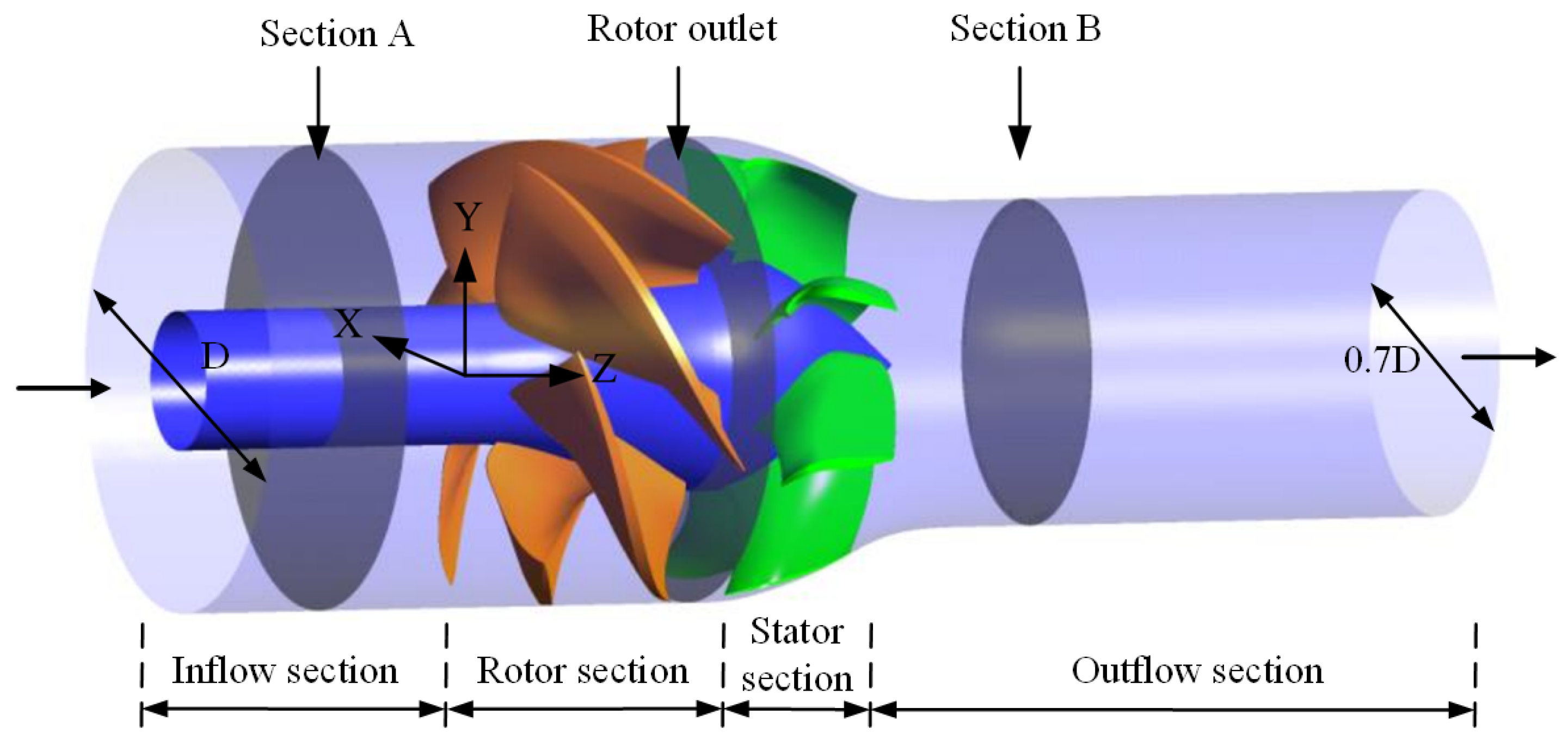

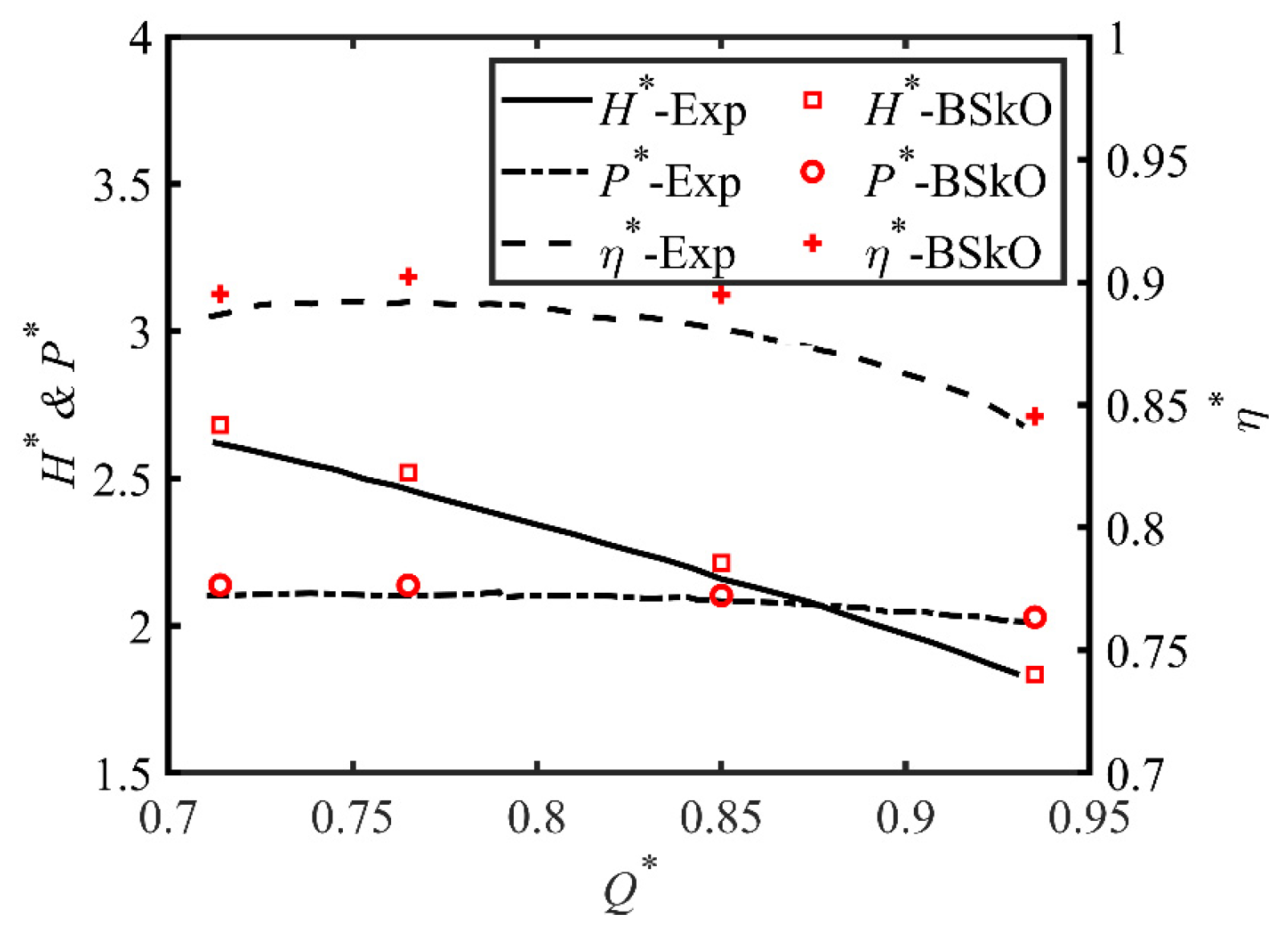
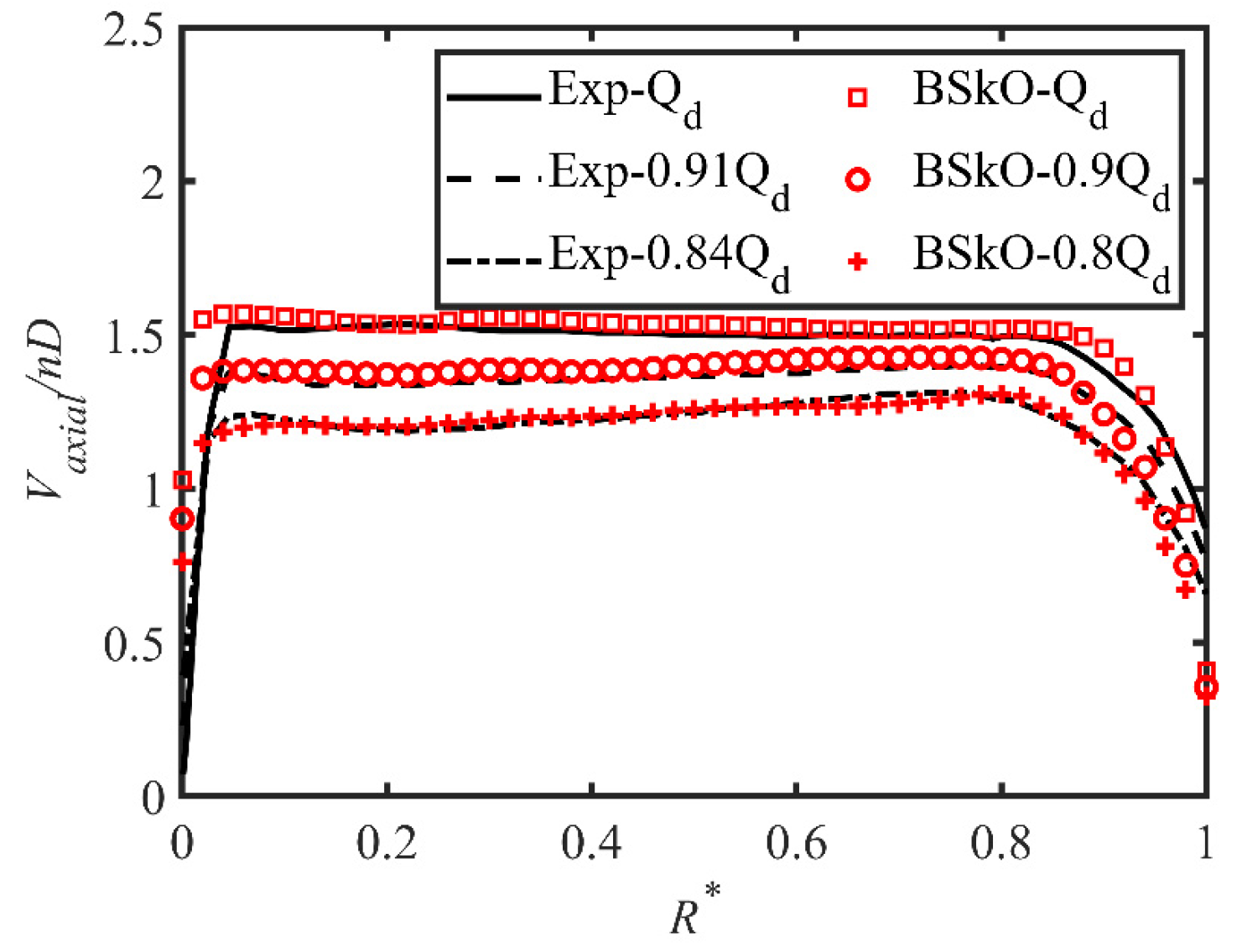
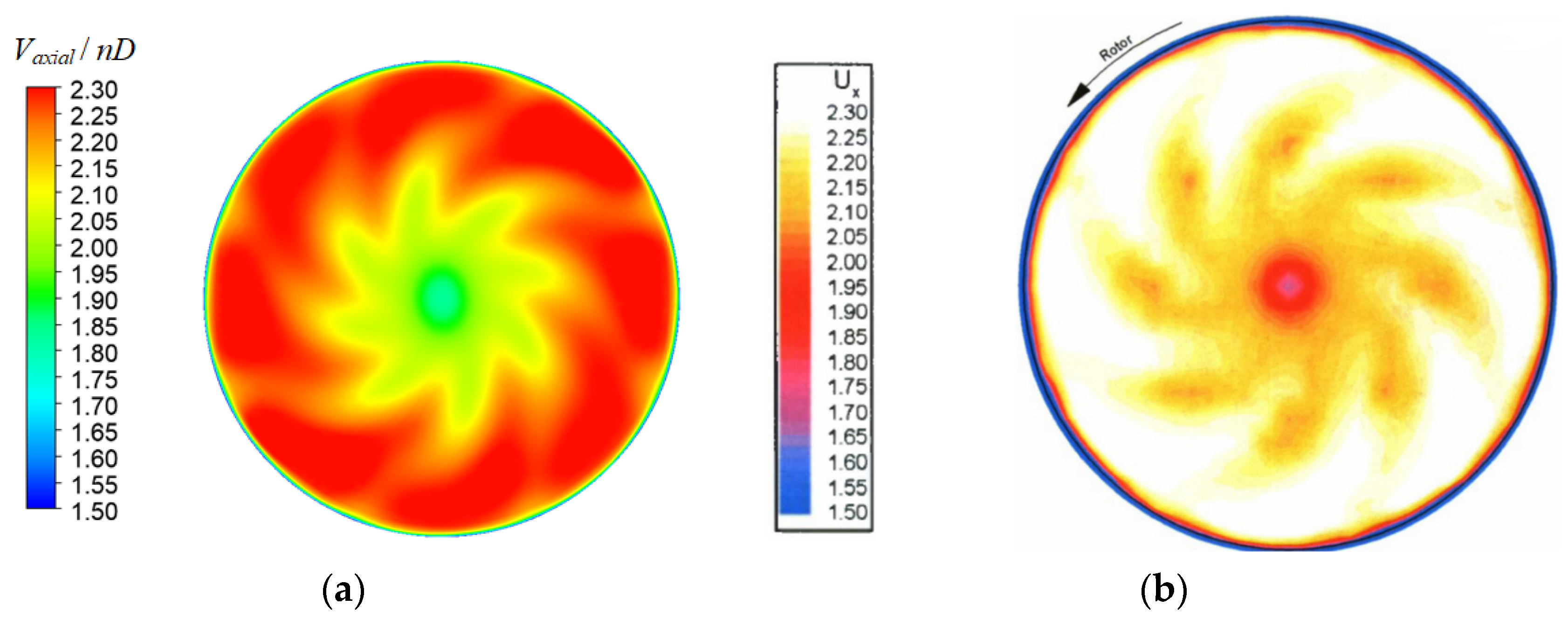

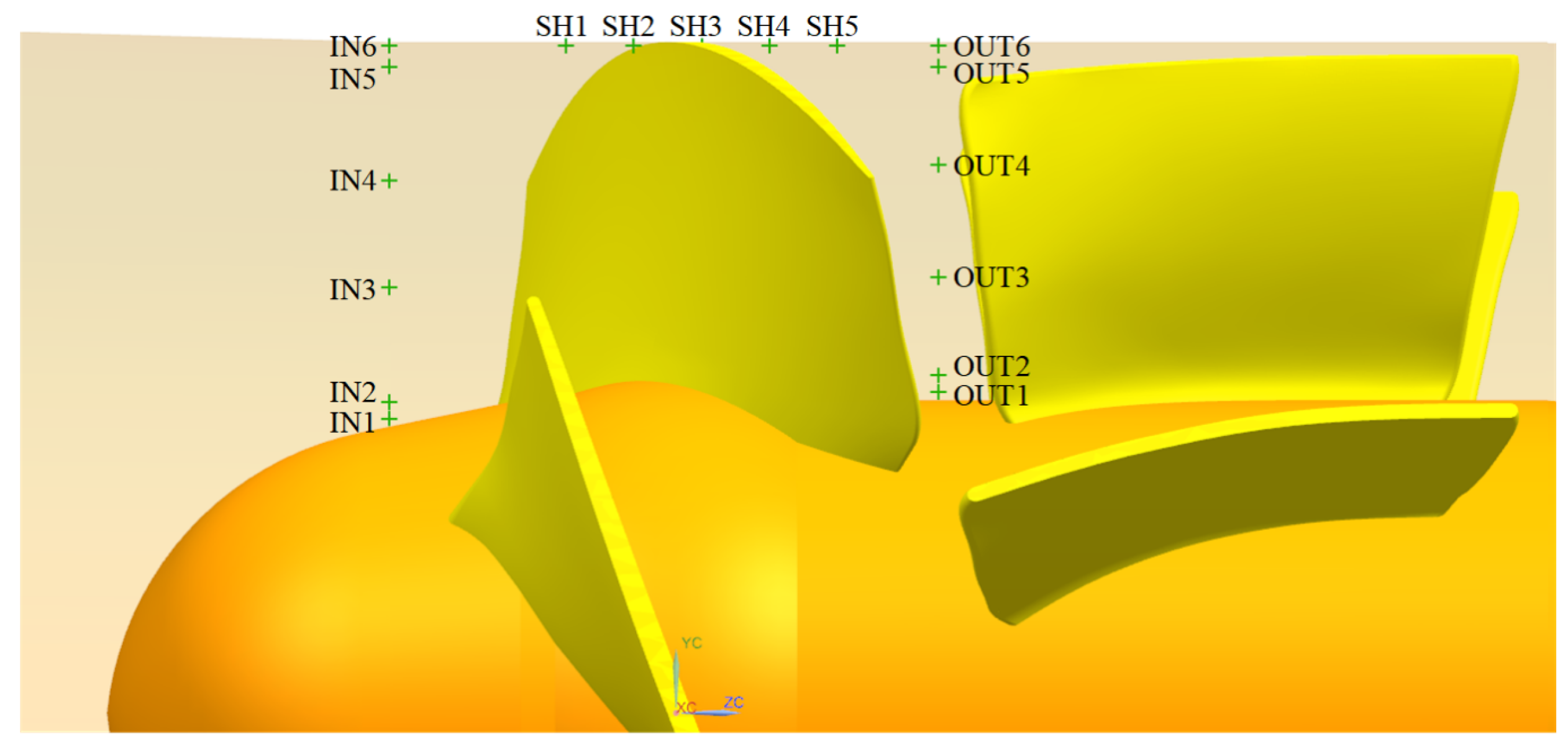
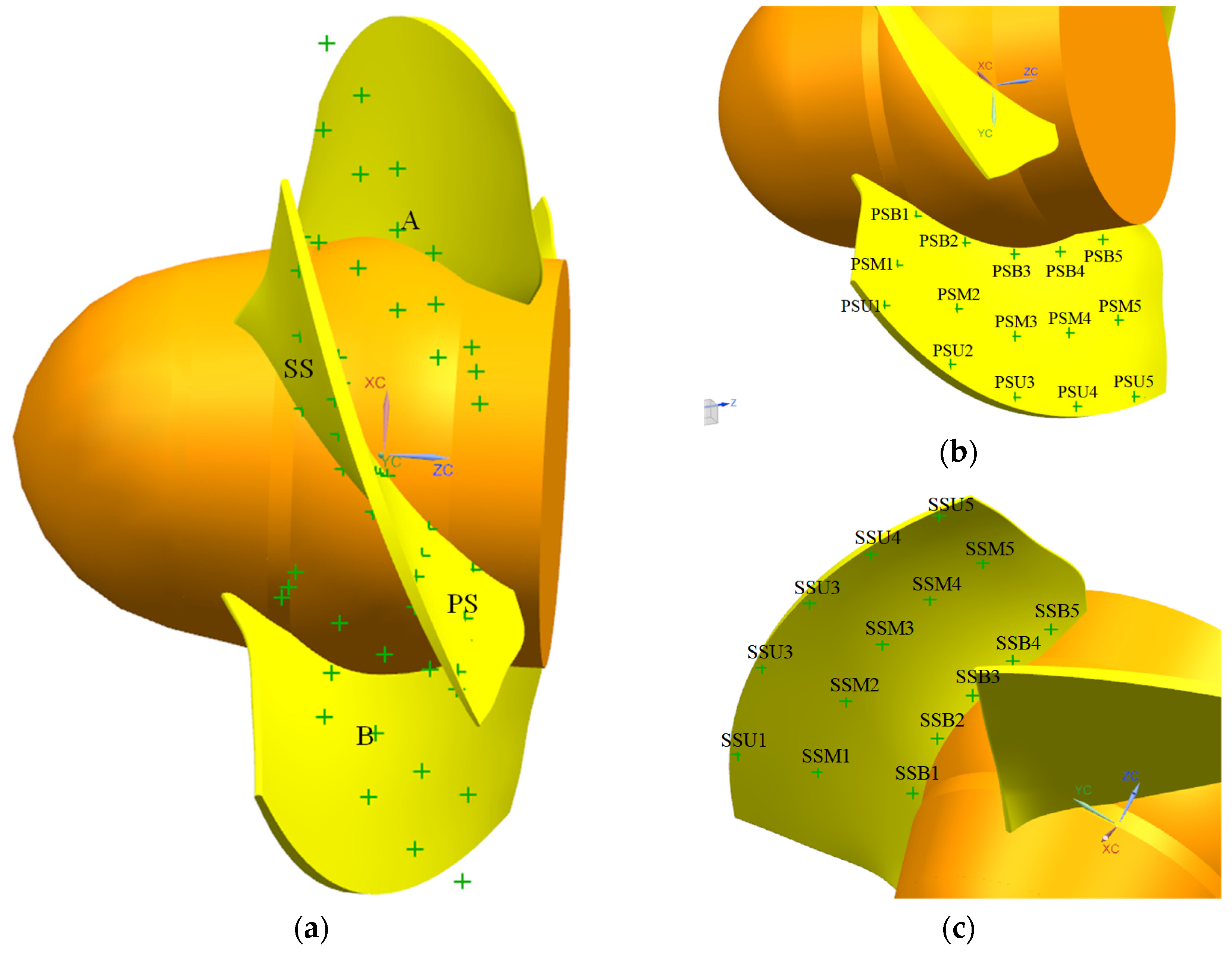
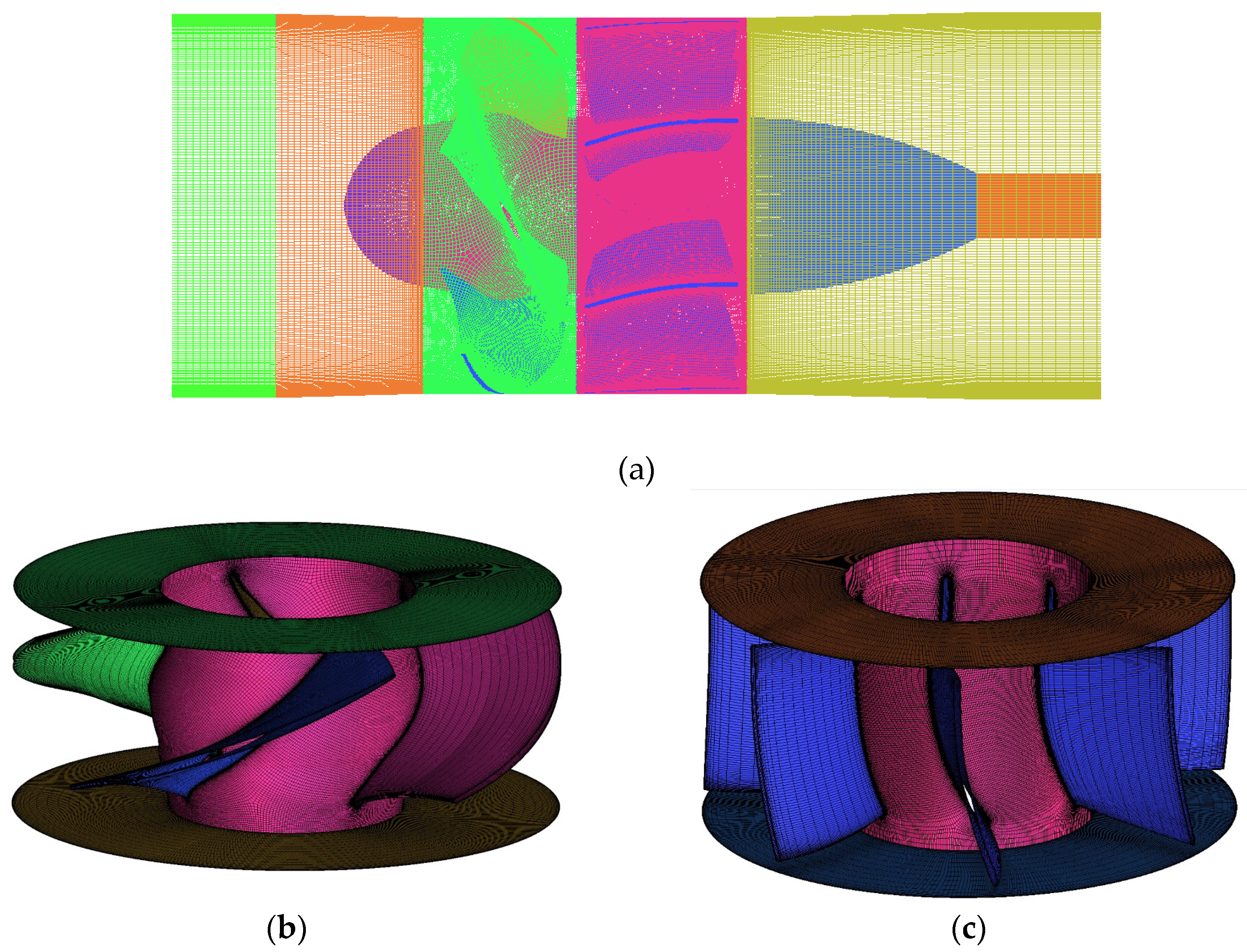
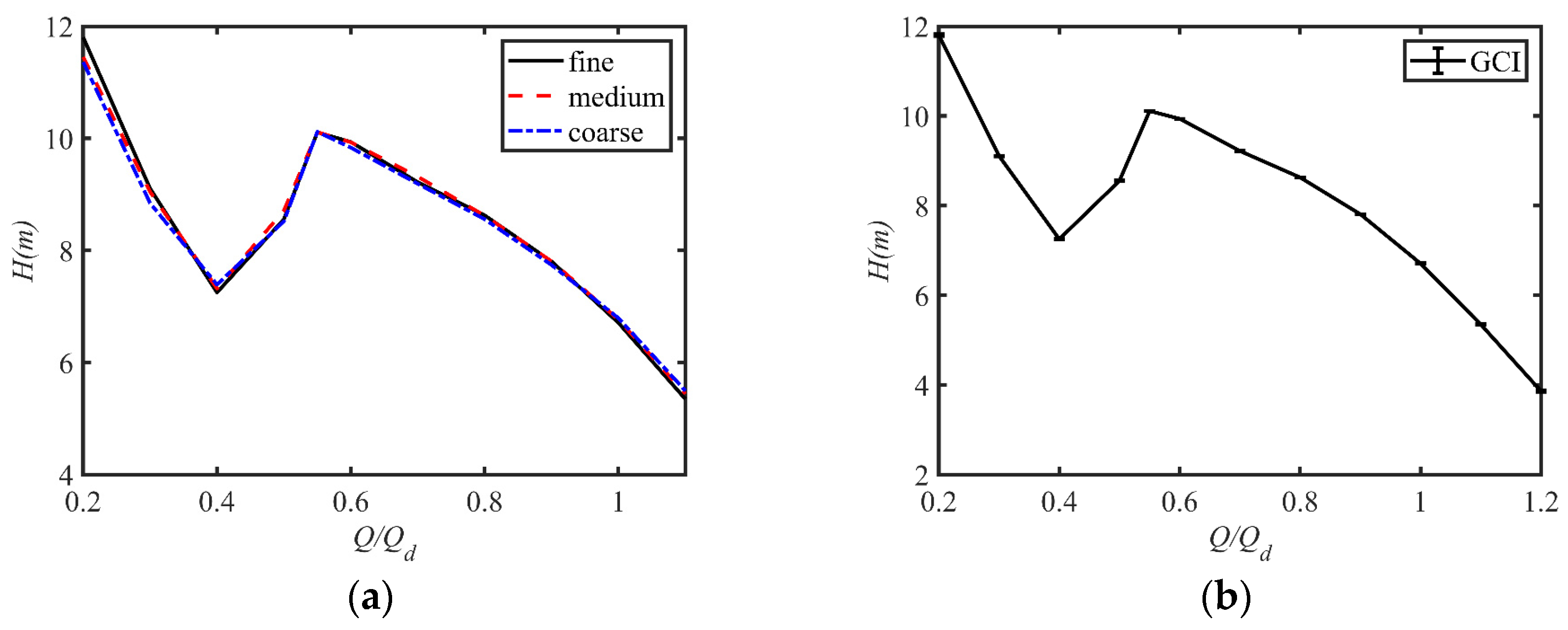
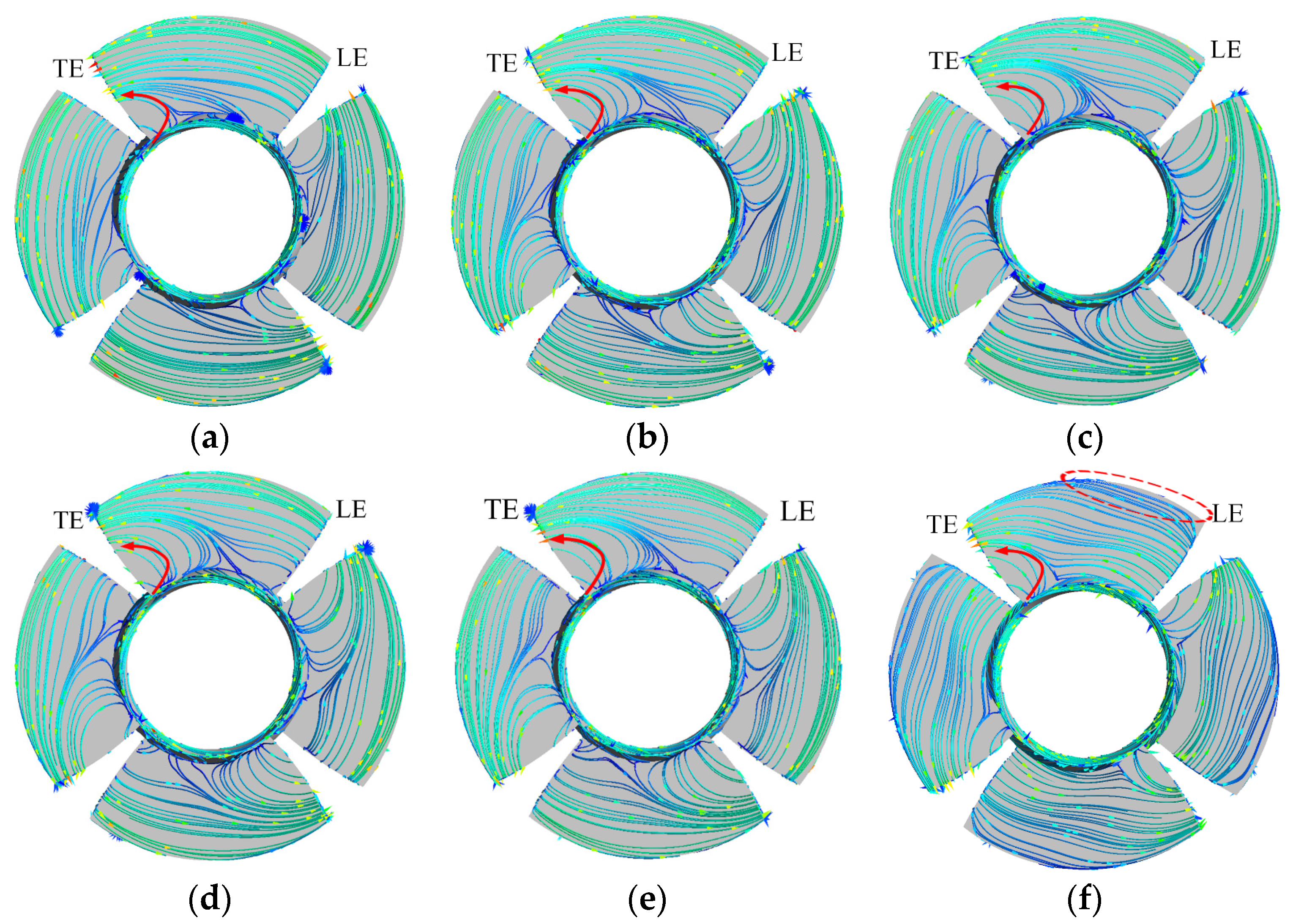



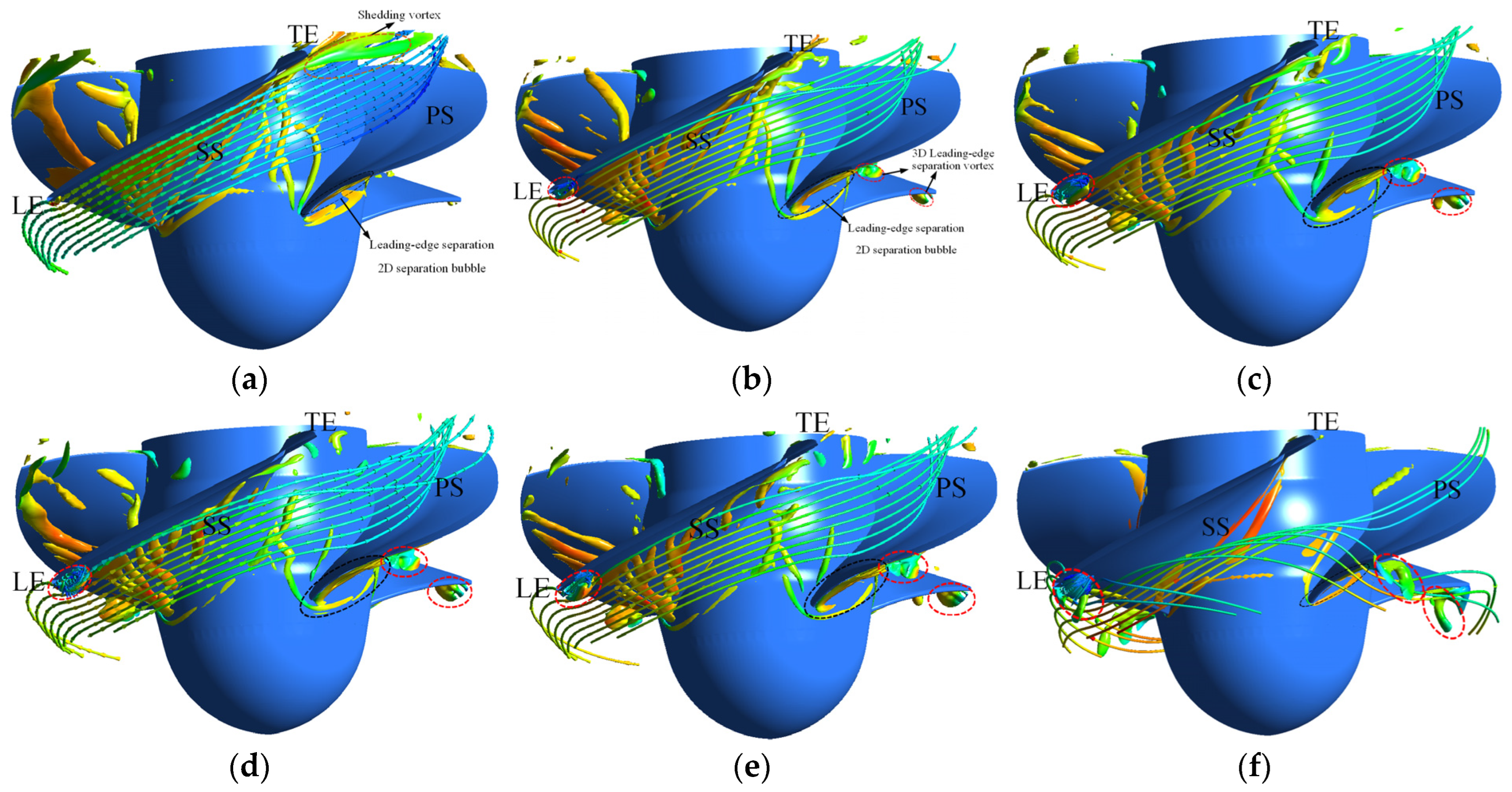
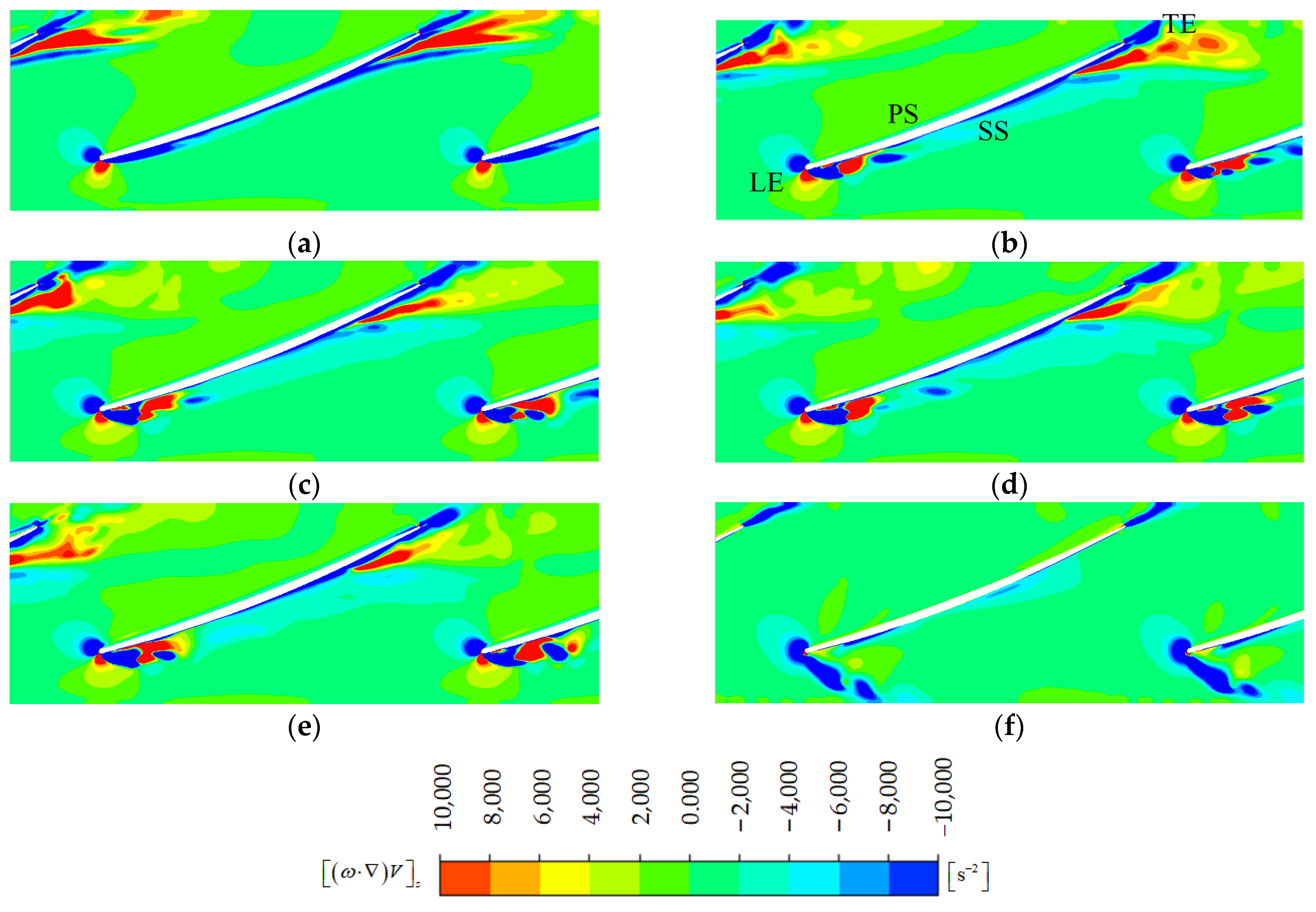

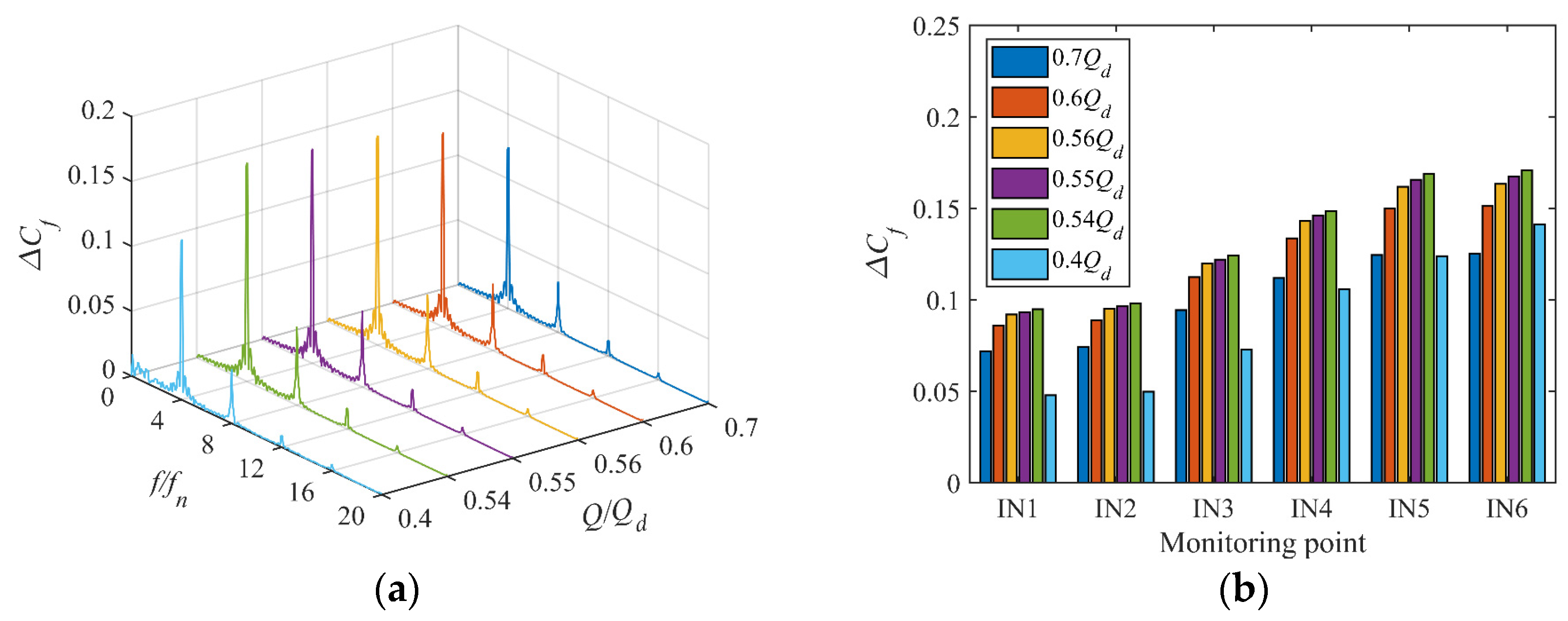
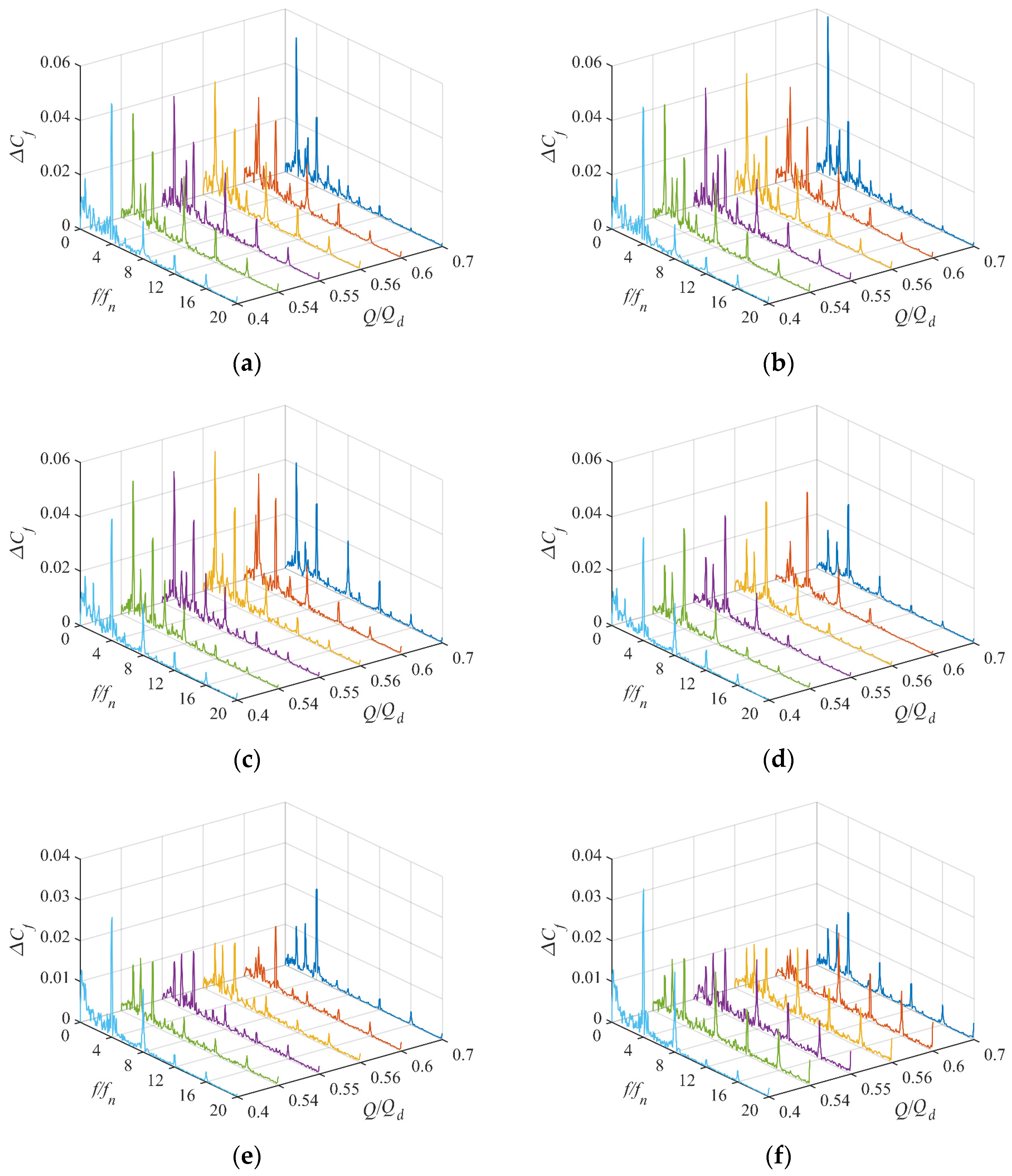

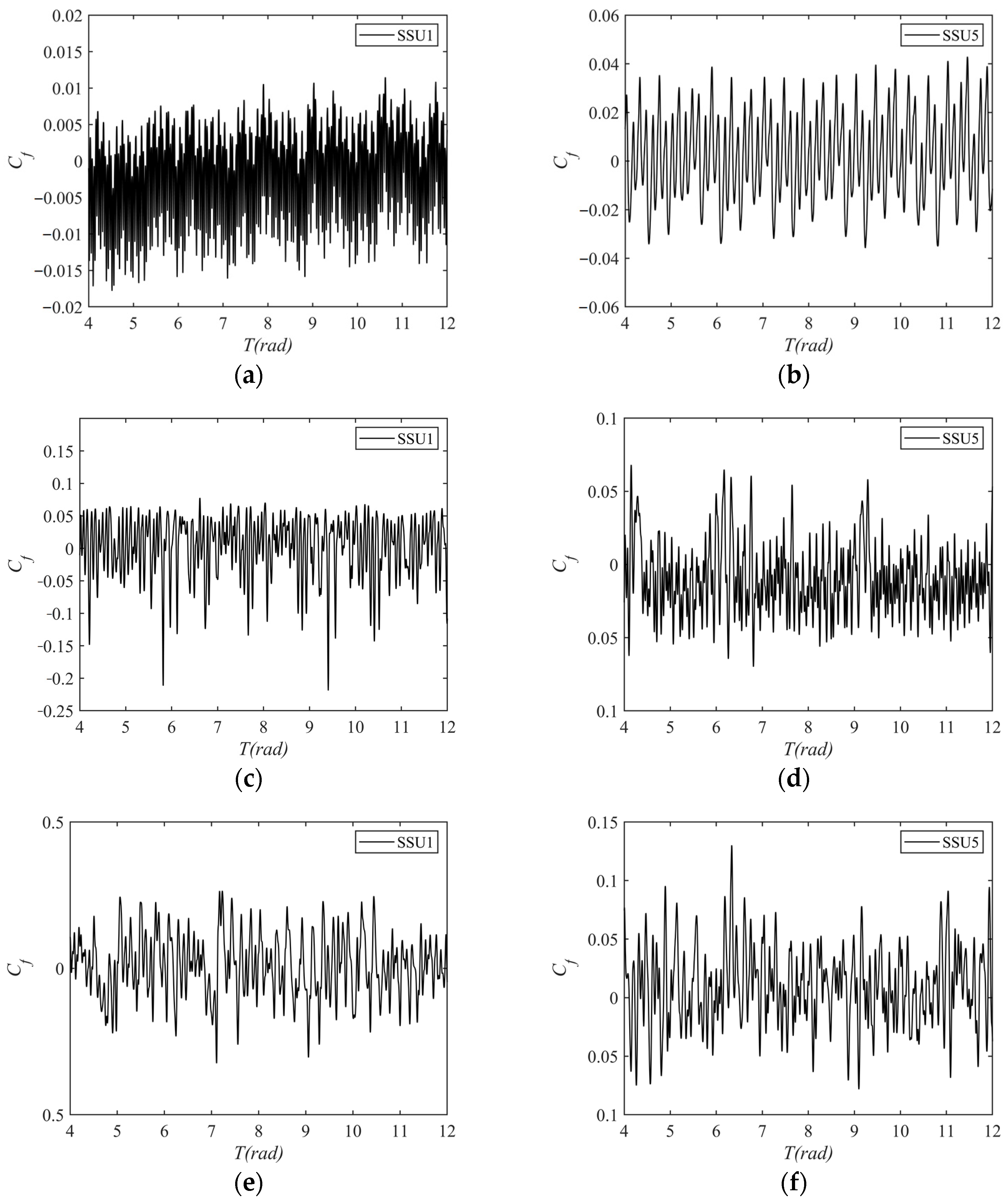

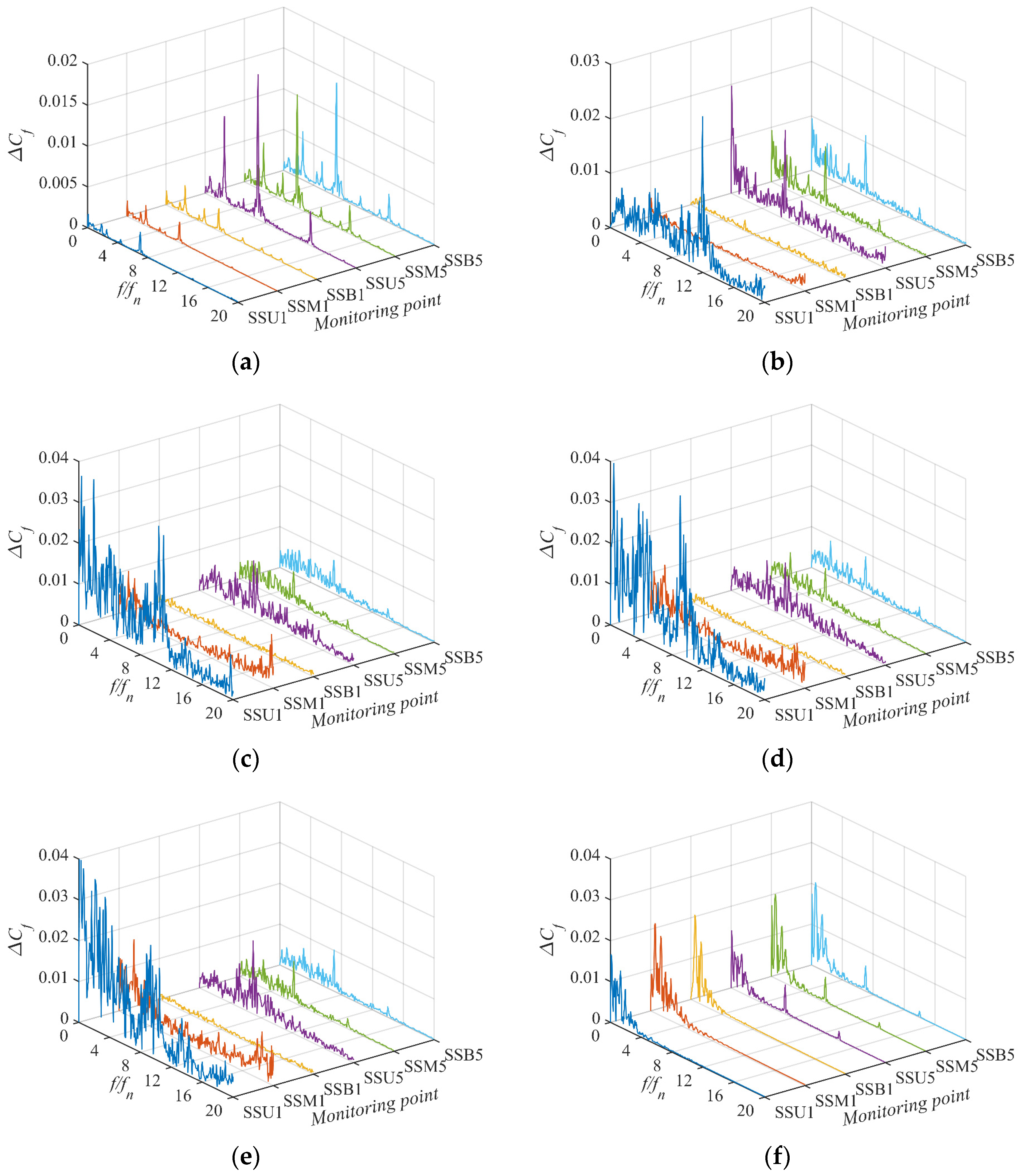

| 0.55Qd—H | 0.6Qd—H | 1.0Qd—H | 0.55Qd—η | 0.6Qd—η | 1.0Qd—η | |
|---|---|---|---|---|---|---|
| φ1 | 10.10847 m | 9.93663 m | 6.71020 m | 61.91716% | 67.94442% | 88.71793% |
| φ2 | 10.11245 m | 9.93153 m | 6.76776 m | 61.72005% | 67.69318% | 89.09831% |
| φ3 | 10.11776 m | 9.83582 m | 6.79235 m | 60.95363% | 66.25159% | 88.60572% |
| φext | 10.12525 m | 9.91512 m | 6.95290 m | 61.08598% | 66.88495% | 90.32200% |
| eext | 0.217% | 0.166% | 3.491% | 1.361% | 1.584% | 1.776% |
| GCIfine | 0.0235% | 0.0307% | 0.512% | 0.112% | 0.130% | 0.1507% |
Disclaimer/Publisher’s Note: The statements, opinions and data contained in all publications are solely those of the individual author(s) and contributor(s) and not of MDPI and/or the editor(s). MDPI and/or the editor(s) disclaim responsibility for any injury to people or property resulting from any ideas, methods, instructions or products referred to in the content. |
© 2023 by the authors. Licensee MDPI, Basel, Switzerland. This article is an open access article distributed under the terms and conditions of the Creative Commons Attribution (CC BY) license (https://creativecommons.org/licenses/by/4.0/).
Share and Cite
Pang, K.; Huang, X.; Yu, K.; Qiu, B.; Guo, Q. Critical State Calculation of Saddle-Shaped Unstable Region of the Axial-Flow Pump Based on Bifurcation SST k–ω Model. J. Mar. Sci. Eng. 2023, 11, 1549. https://doi.org/10.3390/jmse11081549
Pang K, Huang X, Yu K, Qiu B, Guo Q. Critical State Calculation of Saddle-Shaped Unstable Region of the Axial-Flow Pump Based on Bifurcation SST k–ω Model. Journal of Marine Science and Engineering. 2023; 11(8):1549. https://doi.org/10.3390/jmse11081549
Chicago/Turabian StylePang, Kaiwen, Xianbei Huang, Kai Yu, Baoyun Qiu, and Qiang Guo. 2023. "Critical State Calculation of Saddle-Shaped Unstable Region of the Axial-Flow Pump Based on Bifurcation SST k–ω Model" Journal of Marine Science and Engineering 11, no. 8: 1549. https://doi.org/10.3390/jmse11081549
APA StylePang, K., Huang, X., Yu, K., Qiu, B., & Guo, Q. (2023). Critical State Calculation of Saddle-Shaped Unstable Region of the Axial-Flow Pump Based on Bifurcation SST k–ω Model. Journal of Marine Science and Engineering, 11(8), 1549. https://doi.org/10.3390/jmse11081549





